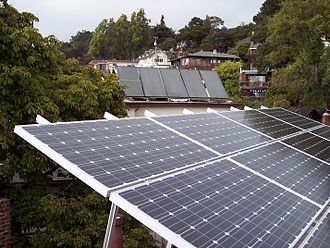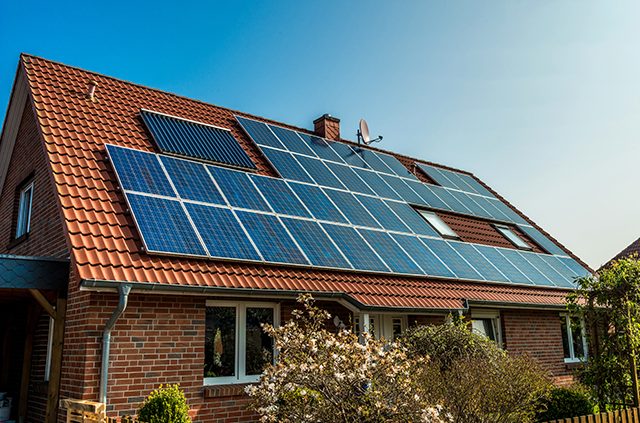
Photovoltaic (foreground) and Solar water heating (rear) panels located on rooftops in Berkeley, California. (Photo: Public Domain)
Rooftop solar monopoly
Will CEC now open up competition to solar power monopoly for new homes?
By Wayne Lusvardi, March 2, 2020 6:31 am
Now that the rooftop mandate for new homes has been relaxed to allow communities to choose cheaper power from municipal solar farms, will new homeowners be allowed to choose cheaper and cleaner conventional energy sources through local Community Choice energy?
On February 20, the California Energy Commission (CEC) granted land developer’s requests for more flexibility in the roll out of the 2019 adopted changes to the state Building Code requiring all new home construction in the state to install rooftop photovoltaic (PV) solar energy panels. The CEC allowed the Sacramento Municipal Utility District (SMUD) to provide owners of newly built homes with solar power from solar farms in the desert, called Solar Shares, rather than by rooftop PV systems.
Environmental advocacy organizations are critical of the CEC’s decision as harming efforts to fight climate change even though the solar farm option would create no greater emissions than rooftop solar. Laura Litman of Climate Group 350, and environmental justice advocacy organization, is quoted on the CalMatters website:
“The concern is that if it’s cheaper for developers to not put solar on people’s homes, then they’re going to opt for that choice. That’s going to undermine the solar homes mandate throughout the state because then other areas and other utilities will ask for that waiver as well.”
But it isn’t certain that electric utilities regulated by the California Public Utilities Commission (CPUC), such as PG&E, So Cal Edison and SDG&E, would be granted the same flexibility given to municipal utilities such as SMUD. However, regulated utilities are subject to the Community Choice law, as elaborated upon below.
Rooftop Solar 2 to 5 Times More Costly
The impartial California Legislative Analyst’s Office has stated that rooftop PV solar is two-to-five times more-costly as from a solar farm. Mia Nakaji Monnier, writing in the CalAlumni Association magazine, also points out the problems with rooftop solar:
- The solar rooftop mandate can be complied with by a shared neighborhood solar mini-farm or by homeowners purchasing or leasing systems.
- Solar panels add $9,500 cost to a new home but can only be recouped over 15 years and systems are made to last 30 years (when the least-costly asphalt roofing lasts 5 to 10 years – authors note).
- Rooftop solar won’t fill all home energy needs 24/7 unless a $5,000 battery is added. Net metering, where homeowners sell excess solar power back to the grid, discourages buying a battery.
- Going solar makes non-solar homeowners pay $65 more per year for others rooftop systems.
- Private homes are not the biggest source of pollution thus the solar mandate will make little difference.
There is no provision in the building code for a homeowner to opt out of the new home solar mandate because it applies to builders.
Enter Community Choice
Customers of California’s regulated electric utilities have only one choice of provider – de facto monopolies. But California’s Community Choice law (AB 117 and SB 790, 2002) allows local communities to select their own source of fuel for electricity generation (sun, wind, hydropower, natural gas, nuclear, geothermal). Community Choice municipalities allow customers to opt out of having to buy green power, but make green power the default choice if a customer doesn’t opt out in writing.
Many municipalities along California’s central coast that opted-in to the Community Choice program have recently been trying to opt-out because they found no savings in the program, according to the Ventura County Star, “Some Ventura County cities plan return to Southern California Edison for some energy accounts.” Communities finding energy savings in the program have been proximate to cheap hydropower or geothermal power in Northern California.
This raises the question of whether the CEC would also allow each municipality to opt out of the Rooftop Solar Mandate for cheaper-cleaner conventional electricity?
Economist Charles Frank of the liberal Brookings Institution has demonstrated that wind and solar are not the best path to lowering carbon emissions. As shown in Table 1 below, Frank concludes that the net cost of solar power is 18.74-cents per kilowatt hour (kWh) compared to 5.64 cents for wind, 1.04 cents for nuclear, negative 3 cents for hydropower, negative 1 cent for nuclear and negative 3-cents for natural gas. In other words, natural gas power and hydropower are about 7 to 57 times respectively less costly than solar. But environmentalists and California energy policy makers claim that conventional natural gas power is contributing to warming the planet. One of the major reasons the costs for solar power are so much higher is that it is only available about 6 hours per day when the sun shines.
According to Frank, however, the net environmental benefits of replacing natural gas with solar is a negative 13.6 cents and the net benefits from natural gas are a positive 6.6-cents per kilowatt hour (see Table 2 below). Conversely, natural gas power reduces much more emissions than coal power because it can produce at 90 percent efficiency all day. In other words, there is no net environmental benefit from solar power but there is from natural gas power.
Frank concludes: “…renewable incentives that are biased in favor of wind and solar and biased against large-scale hydro, nuclear and gas combined cycle are a very expensive and inefficient way to reduce carbon dioxide emissions”.
But will California electricity customers be given a choice to opt-out of monopoly solar power, whether from rooftop systems or solar farms, or even opt into cheaper/cleaner natural gas power, when they buy a new home? And can the courts sustain such a glaring inconsistency between the Solar Power Mandate on new homes and the Community Choice law?
Table 1 – Costs

Table 2 – Benefits

- Peter Gleick’s National Water Plan for California - October 12, 2020
- Court Opens Up Big Prop.13 Loophole for ‘Public Franchise Fees’ - October 2, 2020
- New Cal Grid CEO is Ex-Enron Green Power Trader - September 29, 2020





2 thoughts on “Rooftop solar monopoly”